Content
Fiber optic
Optical fiber is a flexible fiber that transmits light between two ends of a fiber and allows transmission over larger distances and bandwidth (data rate) than electrical cables.
It is one of the most commonly used guided transmission media (especially in recent times) for high-speed data transmission or for long distances.
Its low attenuation and immunity to electromagnetic interference (transmits optical and non-electrical pulses) makes it ideal for data transmission in operator and large enterprise environments.
Although initially its cost was higher, it is already fully competitive with other means of transmission (coaxial cables and twisted pair) since it is also a light cable and easy to install
The optical transmission system
Optical fiber is a cable formed by one or more fiberglass wires through which a beam of light travels.
Optical fiber is based on the principle of optical transmission
This principle is based on confining a light signal within a glass conductive wire (core) using an outer layer that reflects the transmitted light causing it to remain confined within the nucleus.
The Snell's Law relates the angles of refraction of light in a change of medium with the refractive indices of each medium, using the following formula:
n_1\cdot \sin\left( \phi_1 \right) = n_2\cdot \sin\left( \phi_2 \right)Being n_1 and n_2 the refractive indices of the transmission media: core and cover respectively
During the manufacturing process of the fiber, these are coated with a protection of 250 \mu m, covering the core and cover assembly
This protection ensures minimal non-deformability and hardness for use in transmission systems
On this protection is also applied a coating that can be two types:
-
Loose tube fibers
it is mainly used for outdoor installations, since the cable is exposed to temperature changes where the coating allows some slack in the case of expansion
-
Tight coating fiber
it is used in indoor environments and is completely covered by a plastic protection of 900 \mu m
Being more sensitive to temperature changes by not allowing the expansion of its components without affecting their transmission properties
Constructive characteristics
It is one composed of one or more glass threads forming a structure with the following format:
- A fiber core (glass wire) with a high refractive index
- A cover covering the core of similar material but with a lower refractive index
- A wrap that isolates the fibers and prevents interference between them in addition to protecting the kernel
The information must be converted into beams of lights (by means of Led or Laser emitting devices and optical receivers at their ends)
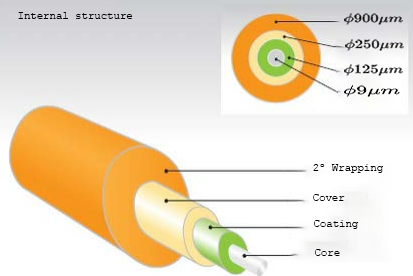
One of the basic parameters in optical fiber is the relationship or ratio between the core and cover refractive indices, giving rise to two types of fiber:
-
Single-mode
the relationship of core and cover refractive indices only allows the transmission of a single transmission mode
Hence its single-mode name. A mode can be interpreted as a single transmission channel
High performance is achieved by not having intermodal interference reaching large bandwidth of around 50 and 100 Ghz
-
Multimode
the ratio of core and cover refractive indices allow transmission of various transmission modes
Hence its multimode name
The propagation of several transmission modes causes intermodal dispersion to appear which translates into worse transmission performance and as a consequence lower transmission speed reaching 1 Ghz
Within multimode fibers there are two types:
- index jump
- gradual index
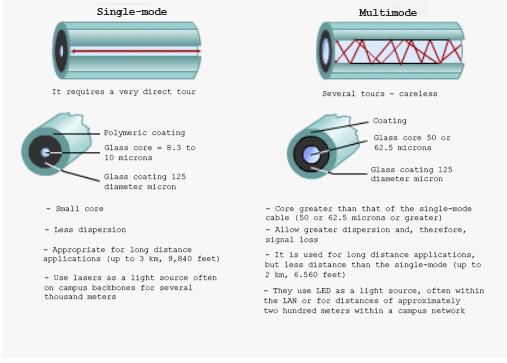
Transmission features
Fiber has a number of features that make it ideal for high-speed data transmission
These features mainly are:
- High bandwidth (around 50 and 100 Gps) for voice, data, video, etc
- Very low attenuation with distance (0.1 dB/km), ideal for long distances
- Low error rate, BER < 10-11 so the transfer rate that can be obtained is very high
- Immune to electromagnetic interference, as it transmits beams of light and not electrical impulses
- Corrosion resistant and good temperature performance
These properties are common to the different types of existing fiber (single-mode and multimode) although as already mentioned above, in the case of single-mode the bandwidth that is reached is greater than in multimode
Applications: Use of frequencies
Fiber optics presents a series of commercial formats where each of them has unique characteristics that make them appropriate for one application or another
These commercial formats are as follows:
| Type of optical fiber | Trade name | Core/cover diameter | Maximum distance Gbps Applications |
|---|---|---|---|
| Multimode | |||
| OM1 | 65,5 / 125 \mu m | 32 m | |
| OM2 | 50 / 125 \mu m | 85 m | |
| OM3 | 50 / 125 \mu m | 300 m | |
| OM4 | 50 / 125 \mu m | 550 m | |
| Single-mode | |||
| OS1 | 50 / 125 \mu m | 2 km | |
| OS2 | 50 / 125 \mu m | 10 km |
In practice, the standard formats OM1 and OM2 are deused so only om3 and om4 formats are used for the vast majority of installations
OS1 and OS2 formats are used for long distances
Types of joints: Advantages and disadvantages
Different types of joints are used, more common are:
-
FC
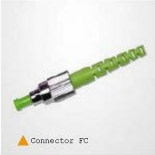
used for long-range fibres
-
FDDI
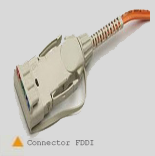
used for medium and long-range connections
-
LC
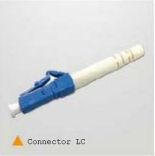
is best suited for data transmission at high speeds
-
SC
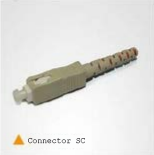
is the most used for mid-range data transmission
-
ST
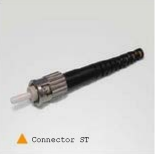
widely used for security systems
Among all of them, sc and lc formats are the most widely standardized
To transmit light signals through optical fibers, an emitting element is required at the beginning that converts the electrical signals into optical (I/O) and another at its end that converts the optical signals into electrical ones again (O/E)
Electro-optical converters are manufactured based on the combination of the following elements: Indium (In), Gallium (Ga), Germanium (Ge), Silicon (Si), Arsenic (As), Phosphorus (P), which have proven to be the most suitable for the manufacture of these devices
Semiconductor technology made it possible to build small, low-cost light emitters and detectors
There are two options of semiconductor sources to be used in optical fibers as light emitters:
-
LED diodes
It is a diode of semiconductor material that forms a P-N junction of the same characteristics as a conventional diode of germanium or silicon
The main difference with conventional diodes is that certain materials that are used as dopators in the LED are chosen in such a way that the electronic recombination process is radioactive and light is generated.
Depending on the material used in its manufacture, led diode will emit visible light or another color
Due to the large scattering of light and the wide spectral distribution of an LED diode, it is used only when transmissions are required at short distances and with little power output.
They are relatively inexpared and have a very long shelf life (107 hours)
-
Laser Diode
The LASER is basically a semiconductor diode that when polarized directly emits a coherent, monochromatic and very narrow light in its spectral width, from 1 to 5 mm
This light, due to its narrow spectrum, does not scatter as much as the light produced by LED diode, so it can be used efficiently for transmissions over a long distance and at frequencies well above 300 Mhz
It is a more expensive device than the LED diode but is used for transmissions over long distances, although today with its wide diffusion and for reasons of economy of scale its price is already competitive with the LED diode
For the reception of optical signals and their conversion to electrical signals, optical receiver devices are used, which can be of two types:
-
Phototransistors
They are receivers that have good sensitivity but are not suitable for high speed rates
-
Photodiodos
They are semiconductor diodes but inversely polarized with which they act as optical to electric converters
They are low latency devices, very fast, high sensitivity and that make it very suitable for high speed transmissions
They are further classified into two types:
- Pin photodiode
- APD photodiode
